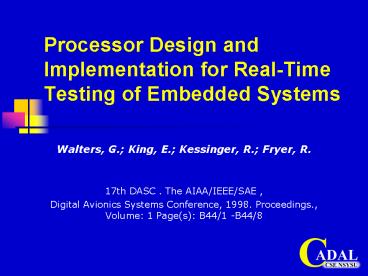Processor Design and Implementation for RealTime Testing of Embedded Systems - PowerPoint PPT Presentation
1 / 23
Title:
Processor Design and Implementation for RealTime Testing of Embedded Systems
Description:
Digital Avionics Systems Conference, 1998. Proceedings., Volume: 1 ... Inserted in an Air Force avionics system. provide 12 DAIS MIPS sustained at 60MHz. MS1 ... – PowerPoint PPT presentation
Number of Views:112
Avg rating:3.0/5.0
Title: Processor Design and Implementation for RealTime Testing of Embedded Systems
1
Processor Design and Implementation for Real-Time
Testing of Embedded Systems
- Walters, G. King, E. Kessinger, R. Fryer, R.
- 17th DASC . The AIAA/IEEE/SAE ,
- Digital Avionics Systems Conference, 1998.
Proceedings., Volume 1 Page(s) B44/1 -B44/8
2
What Problem ?
- Design and implement processor that are
compatible with commercial instruction sets and
have specific features for visibility to
facilitate to test ,debug, and maintenance of
real-time processing system. These features
include - Real time Non-intrusive instrumentation(RTNI)
- Behavioral Verification Technology(BVT)
- Do not interfere in any way in the operation of
the system.
3
Introduction
- The advance of combination of RTNI and BVT
- Reduces system validation time ,risk and cost.
- Increasing the coverage and assurance level
- The feature implemented in processor
- High performance
- Low power,commercial grade, or radiation hardened
- Development of processor military and commercial
application
4
Background
- DOD-design embedded processors contained in
avionics system have incorporated test hooks to
facilitate the debugging of the system and
software - Most of Commercial-Off-The-Shelf (COTS) have not
included RTNI for real-time software application
5
Real time Non-intrusive Instrumentation (RTNI)
- The software bug often do not appear until the
system has been fully integrated and running at
speed. - Real time execution causes event timing and the
CPU profile to change, since it is affected by
real-time interrupts, real-time
task-switching,and inter-task dependencies.
6
Bus-based debugging system
- That is blind when MP is doing in no bus cycles
at system bus. - That is unable locate instruction or operand
boundaries within the block of memory accessed. - This force s firmware/software developer to
intrusively trap real time code.
7
Solve Bus-based problem
- The instrumentation mechanisms must be
transparent to the behavior of the software. - Transparency has typically been deemed adequate
- If the flow of addresses in program execution is
identical - If the time relationships of all software
detectable events are equivalent - i.e. interrupts,sequence of procedures run,time
spent in a process.
8
(No Transcript)
9
The debug functions of RTNI supports
- Trace Stop/Start on Event
- Single Step
- Software/Hardware Breakpoints
- Inspect/Change Memory
- Up to (16) Hardware traps
- Timers/Event Counters
- Event Timing
- Inspect/Change Registers
- Inspect/Change I/O port
- Reset/Configure Performance Monitor
- Enter/Exit Console Mode
- Reset RTNI
- Run/Stop
10
(No Transcript)
11
The RTNI specifics
- The interface is made up of
- 8-bit command bus
- 32-bits data bus
- 14-bits status bus
- The data bus is used to
- Specify the register number for read/write
register commends - Specify the address for read/write memory/IO
commends - Specify the data value for write commends
- Provide the data value for read commends
- Provide the trace data when trace is enable
12
The RTNI specifics (cont.)
- The status bus is to indicate
- RTNI can accept a new commend
- Current RTNI commend complete
- Current state of the microprocessor
- Valid trace data
- First word of multi-word trace packet
- Hit/Miss status for the internal breakpoint
register
13
The application of RTNI
- Support industry standard symbolic debugger
through an Application Programming Interface
(API). - Implemented as a general-purpose diagnostic port
architecture which is open, scalable and
consistent with commercial development tools.
14
The characteristics of BVT
- It is automated, checking against expected
results thereby eliminating the uncertainty of
ad-hoc,random testing. - It is based on a measurable and enforceable
specification . - It provides comprehensive specification coverage.
15
The characteristics of BVT
- It is applicable throughout the development
process as well as on the finished product. - It integrates new tests as the specification
evolves or as the developer requires. - It provides repeatable
and predictable test results. - It is easy to use.
16
The test procedure of BVT
17
The bootstrapping Validation Fashion
Simplest function
Complete system
Incremental
18
The basic organization of BVT
- Basic Function Test
- Focus on each individual operation or function
are working properly - Also verify that unwanted side-effect do not
exist. - Example
- proper result is calculated
- register and memory are update correctly
- condition code are set properly.
19
The basic organization of BVT
- Corner Case Test
- boundary conditions cases of a function
- Example
- underflow or overflow in floating point
operation - Cause address calculation to cross memory
boundary - exception cases of a function .
- Example
- Proper prioritization of multiple exception
20
The basic organization of BVT
- Sequence Tests
- Multiple functions are executed sequentially or
concurrently - Sequences of multiple instructions interact
properly - Example
- Dependencies between instruction for register
values,memory contents,and flag settings.
21
Applications
- CPU-1750A
- Inserted in an Air Force avionics system
- provide 12 DAIS MIPS sustained at 60MHz
- MS1
- An x86-compatible micro processor
- Developed in conjunction with Navy
- BVT provides more test coverage than
vector,application and/or random testing.
22
Conclusion
- RTNI
- Single cycle execution of COTS processor.
- Standardized across multi-processor including
DSP - Visualize real-time data allows developers to
isolate where and why a particular real-time bug
occurs.
23
Conclusion
- BVT
- Based on the systematic verification of the
specification - Significantly more effective in finding,
identifying, correcting, and re-testing bugs - Created to validate specifications for both
software and hardware

